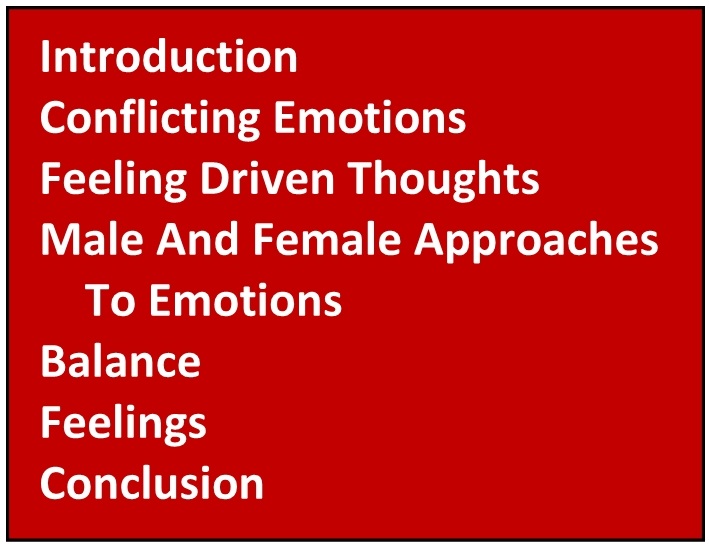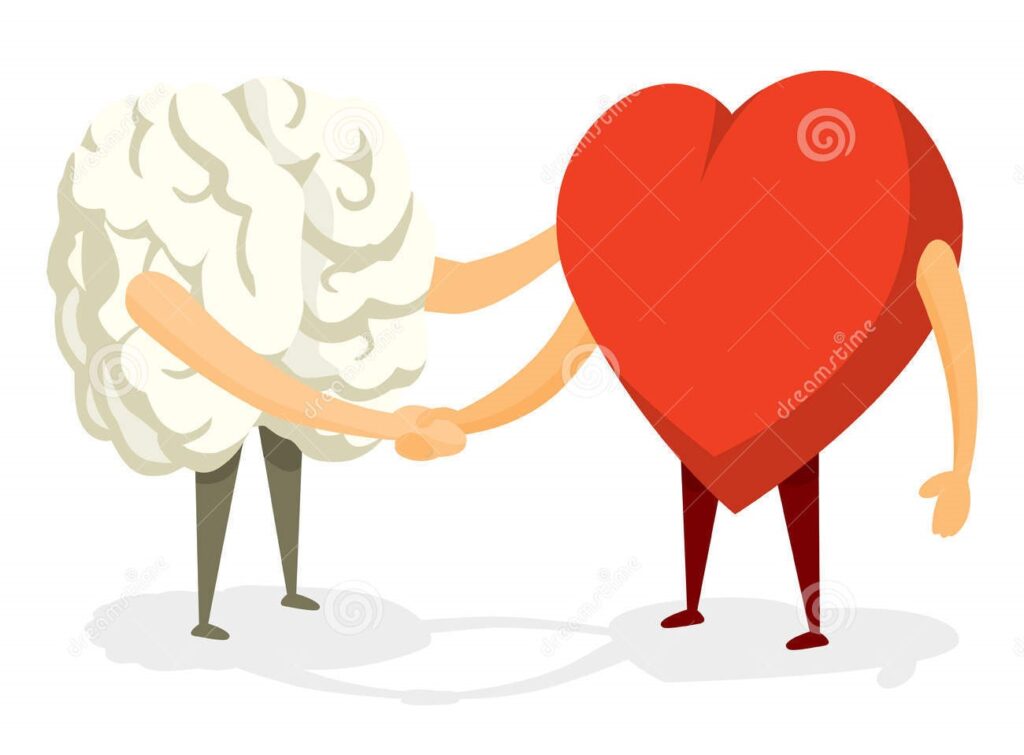Emotions and Feelings: Their Functioning Part (II)
INTRODUCTION
In Part (I) we said that emotions consist of the combination of feelings and thoughts working together. As we discuss the functioning of emotions and feeling you will see the usefulness of this definition. We continue to lay the theoretical groundwork that will result in techniques for working with emotions, feelings, and thoughts.
CONFLICTING EMOTIONS
There are times when our emotions conflict with each other. The thoughts are contradictory and the feelings are what we call “mixed.” For example, “I think that the best thing for me is to delay eating this ice cream. At the same time I want to eat this ice cream now.” We are experiencing the inner conflict of wanting and not wanting something at the same time—ambivalence. The intensity of inner conflict can range from mild to moderate to intense to devastatingly severe. Our emotions fight it out within us causing feelings of tension and stress, anxiety, depression, and ambivalence. The inner conflict may be so painful that we deploy our defense mechanisms. (endnote for def mech !!!)
Conflicting emotions give rise to less effective, confused, half wanted, and contradictory actions and what we say can contain contradictions. Our verbal and non-verbal contradictory communication is confusing to the people we talk to.
Consider the following for example. I am angry at my partner and since I can express my angry in a constructive way, I go ahead and express that anger. However, if my expressions of anger are destructive in some way, I may block or distort my expression. I may smile as I say angry words which communicates the thought, “I don’t really mean what I am saying.” This communication is confused and the other person does not take you seriously. The inner conflict is: “I love my partner I don’t want to hurt him or her with my destructive expression of anger. At the same time, since I am angry I want to express my anger.” The resulting behavior reflects both the desire to express and the desire to hold back at the same time.
Point of Empowerment: Our strongest, most powerful actions occur when our emotions, feelings, and thoughts are all moving together in the same direction.
FEELING DRIVEN THOUGHTS
Our feelings generate thoughts if the feelings come first. This can be a strength and a weakness that creates distortions. For example, as a strength: “I feel hurt and am driven to think about why so I can become more effective in handling situations where I feel hurt.” “I feel happy and am driven to think about why so I can feel happy more often.” As a weakness, a distortion occurs when the thoughts that arise from feelings are not “realistic”—they are not accurate perceptions about the reality of our life. These distortions often occur in childhood when we have lots of feelings but our ability to process them with realistic thoughts is limited. Distortions also occur when we feel very afraid (experiencing intense fear), because these feelings can make clear thinking hard or impossible. Our thinking ability is reduced, overwhelmed by feeling. Under these circumstances, our thoughts seem “right” but are based on limited information, understanding, or experience or provide overly simplistic explanations. For example:
- I read a newspaper headline that creates fear and think about the dangers coming. But with additional information it becomes clear
 that the dangers are not as severe as presented.
that the dangers are not as severe as presented. - I see my sister laugh as my parent hits me and think that she is happy that I am being hit. But with additional information I understand that her laughter comes from being anxious as she witnesses what is happening.
- My spouse frequently seeks compliments. This annoys me and makes me angry. In my thinking I condemn him/her for it. But with understanding I see that this behavior is motivated by low self-esteem. With compassion, I feel love toward him/her when he/she seeks compliments.
- I am in a small restaurant, train, or airplane and start to feel anxious. I observe my surroundings and conclude that I am afraid of restaurants, trains, or airplanes. But with further understanding I realize that my anxiety comes from an irrational thought that I could be trapped and die in these small spaces. As I examine these circumstances I overcome my anxiety by understanding that these small spaces will not hurt me.
MALE AND FEMALE APPROACHES TO EMOTIONS, FEELINGS, AND THOUGHTS
Men and women approach and experience emotions differently because they often value thought and feeling differently. Men tend to emphasize thinking and women tend to emphasize feeling. Men are “logical and rational.” Women are “emotional.” (However, there are some men who are more “emotional” and some women who are more “logical and rational.”)
We may say that something is logical or that it makes sense and give it “extra weight,” it seems to be true and believable. We can believe in the truth of a logical statement. “Being logical” and acting according to a thought is often labeled as a “male” approach. Being “illogical” and acting on a feeling is labeled as a “female” approach. Both “approaches” are incomplete because emotion consists of both a feeling and a thought. When we split and isolate thought and feeling we create distortions. Sometime these distortions are very destructive.
- “War is good and necessary when what we want is refused to us.” A logical statement devoid of the feeling of the tragedy of war.

- My aggression is justified if I have been offended. A “logical” statement that is out of touch with the hurt of an offense, ignores the impact of feeling hurt on emotions, and encourages thoughtless impulsive retaliation.
- If I feel attacked I can feel justified attacking back. My feeling makes my actions right without thinking about or understanding the other person’s point of view.
- If feel hurt and afraid I can retreat into myself and shut others out. My feeling drives my behavior without considering or understanding the strength I have to cope with feeling hurt and afraid.
Point of Empowerment: To live effectively by using our emotions, we need to recognize the importance of both feeling and thought. We seek a balance between them, a balance between the “male” and “female” approaches, honoring and respecting each.
Point of Empowerment: Thinking without feeling can be cold and heartless. Feeling without thinking can be divorced from reality. Thinking with feeling can be loving. Feeling with thinking can be powerful and impactful.
Practice: Think about your feelings and feel about your thoughts.
BALANCE
What are the benefits of a balanced approach to thoughts and feelings?
- Balance between thought and feeling creates objectivity—the ability to evaluate and understand our situation and life realistically. We
 can accurately determine cause and effect.
can accurately determine cause and effect. - We can see that our thinking and judgement about of something can be mistaken because it was created by distorted feeling driven thought.
- Balanced thinking and feeling helps create the ability to respond appropriately and constructively to our reality.
- Balance helps us learn to trust feelings. We know that we will think about our feelings, evaluating their objectivity.
- Balance helps us be comfortable with our thoughts and feelings knowing that we will not act impulsively on just a thought or just a feeling.
- A balanced approach includes questions such as, “How does this thought feel?” or “Is this a loving thought?” We put feeling into thought. This can make our thinking “softer” and more concerned for the welfare of others.
FEELINGS
Our basic feelings are pleasure and pain. Other feelings develop from the basic ones but retain an underlying layer of pleasure and pain. We move toward pleasure and away from pain, desiring more of what brings us pleasure and less of what causes us pain. This is the way feelings operate. As we explore the importance of feelings, let’s remember how they function. Our feelings are so important because they:
- Allow us to experience life
- Help us experience aliveness
- Give us information about events that are happening in our life
- Tell us about what is important in our life and help us make priorities
- Tell us what we love about our life and want more of
- Help guide us toward the directions we want to go in
- Help us determine what we want for our future
- Alert us to danger by generating fear
- Alert us to our inner conflicts
- Help us discover what needs to be healed from the past
- Put energy, enthusiasm, and passion into our actions
- Make our actions more impactful
Point of Empowerment: Since feelings are our experience of life, if you are not fully feeling, you are not fully experiencing and living life. Honor and value your feelings by paying attention to them.
CONCLUSION
In this Letter we explored more about functioning of emotions and feelings. With these ideas we can appreciate and value our emotions, feeling, and thoughts. We will continue this exploration in future Letters and turn to the subject of using and working with our emotions, feelings, and thoughts.
